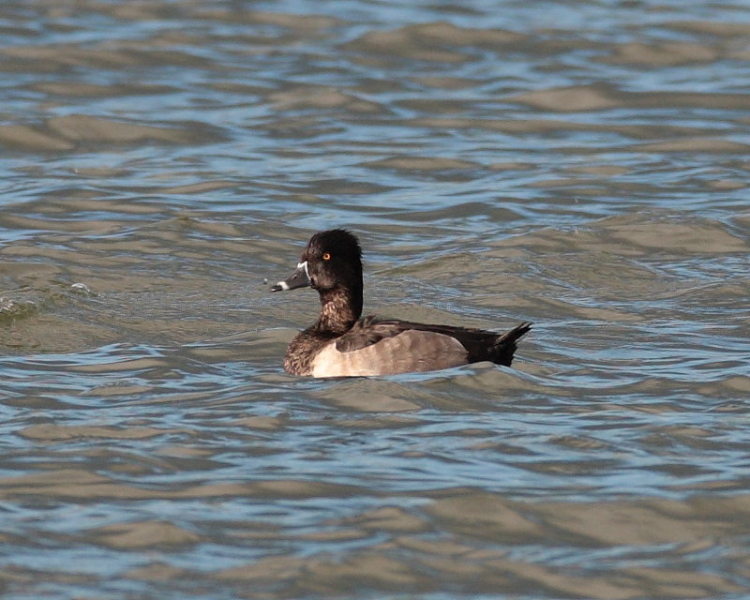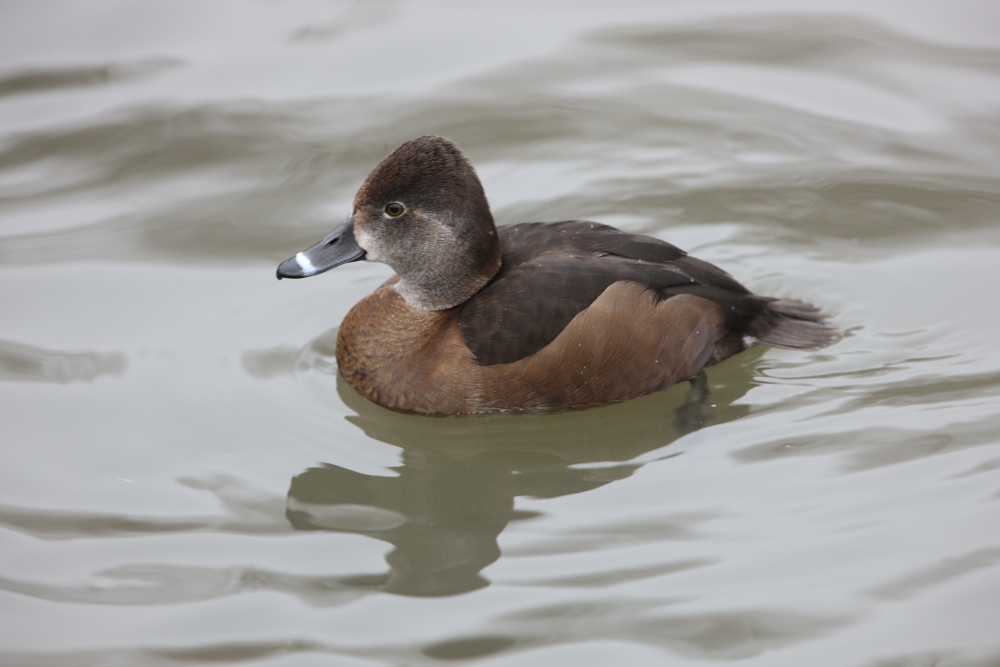Blagdon Lake Birds
Ring-necked Duck Aythya collaris [Donovan, 1809]
(Rare Nearctic vagrant)

- One, male not aged, 4th-21st April 1971 (R.M. Curber et al.), presumed same 26th March to 15th or 16th April 1972 (R. Arbery, S.B. Edwards et al. ). See note 1 below. Presumed same 30th June to 23rd Aug. 1972 (A.H. Davis), presumed same 16th March to 16th April 1973, & 4th June 1973. See note 2 below.
- One, 1st-winter male, 5th-15th Jan. 1977 (A.H. Davis). See note 3 below.
- One, adult male, 24th-27th April 1999 (N.R. Milbourne), presumed same 30th May to 27th June 1999 (A.W. Gibbs, N.R. Milbourne et al.), presumed same 24th June 2000 (R.M. Curber, N.R. Milbourne et al.), & 9th July 2000 (N.R. Milbourne). See note 4 below.
- One, adult male, 26th May to 16th June 2001 (N.R. Milbourne). See note 5 below.
- One, adult male, 15th-29th July 2001 (N.R. Milbourne). See note 5 below.
- One, adult male, 24th July-12th August 2001 (N.R. Milbourne). See note 5 below.
- One, adult male, 30th April 2002 (N.R. Milbourne). See note 5 below.
- One, adult male, 3rd-6th June 2002 (N.R. Milbourne). See note 5 below.
- One, adult male, 4th-29th July 2002 (N.R. Milbourne). See note 5 below.
- One, adult male, 10th-17th Aug. 2002 (N.R. Milbourne). See note 5 below.
- One, adult male, 7th & 19th May 2003 (N.R. Milbourne). See note 5 below.
- One, adult male, 18th June to 26th July 2003 (N.R. Milbourne). See note 5 below.
- One, adult male, 4th-31st Oct. 2009 (N.R. Milbourne, R. James et al.) & presumed same 5th-6th Dec. 2009 (N.R. Milbourne).
- One, adult male, 18th-24th Aug. 2011 (N.R. Milbourne. M. Jenkins et al.).
- One, 1st-winter male, 8th-25th Nov. 2011 (N.R. Milbourne et al.).
- One, adult male, 2nd Nov. 2016 (N.R. Milbourne et al.).
- One, adult male, 12th-13 Nov. 2022 (A. Mears, N.R. Milbourne et al.), presumed same 11th, 17th Dec. to 1st May 2023 (N.R. Milbourne, B. Thompson et al.). Presumed returning individual on 11th Oct. to 17th Dec. 2023 (A. Mears et al.), 19th Dec. 2023 to 11th Jan. 2024 (N.R. Milbourne et al.), 30th Jan. to 20th Feb (N.R. Milbourne et al.) then again from 28th Feb. to 7th Mar. (N.R. Milbourne et al.) and again on 11th to 16th Mar. (N.R. Milbourne et al.).
- One, female, 2nd-8th Jan. 2023 (I. Dickie, F. Clark, M. Hynam et al.).
Note 1: Final date is given as 15th April in Somerset Birds 1972 but 16th April by Andy H. Davis in Birds at Blagdon Lake 1963-1983, Bristol Ornithology 18. Can anyone help clear this anomaly up?
Note 2: Considered by the Rarities Committee to be an extension of 1970 -1972 record according to Howard H. Davis in Somerset Birds, 1973.
Note 3: Immature male spent first half (of January) at BL (last seen on 15th) but returned to CVL for latter half according to Trevor B. Silcocks in Somerset Birds, 1977. On checking Somerset Birds 1976, 3 birds were present at CVL from 29th December 1976 into 1977, so the first date at BL is unclear. However, Andy Davis (pers. comm.) sent me the following note: "The 1977 record of a 1st-winter ♂ was seen from 5th Jan. (I saw it on that date but it may have been seen from 1st Jan?) to mid-Jan (don't know the exact date). It was the same bird as the first mid-Dec record at CVL in late 1976, just before a group of 3 appeared in late Dec." I have, therefore, given the first date as the 5th and the observer as Andy, unless any other information comes to light extending the dates either way.
Note 4: The correct dates are given here. The April dates were published incorrectly in ABR 1999 as 24-27th March. The 9th July 2000 record of the bird in Rugmoor Bay was not published in ABR 2000. Records during 1999 and 2000 were considered to involve the same wandering individual by the Avon Recorder's committee.
Note: 5: During 2001 there were two individuals present at Blagdon from 24th-29th July, therefore, all records from 2001 to 2003 are listed because I cannot be sure which of the two individuals may have been seen after the period they were both at the lake.

I have recorded this as a 'very rare' Nearctic vagrant because many of the above records refer to birds showing site fidelity from year to year that have stayed on this side of the Atlantic. It is probable that as few as 8 to 9 birds account for all the records to date.
This species has undergone a large and statistically significant increase over the last 40 years in North America (247% increase over 40 years, equating to a 36.5% increase per decade; data from Breeding Bird Survey and/or Christmas Bird Count: Butcher and Niven 2007).
Short-distance to medium-distance migrant. Ring-necked Ducks breed in northern North America and spend winters in southern and western North America, northern Central America, and the Caribbean, often on freshwater. Much of the population migrates from central Canada to the southeastern United States, staging along the way in Minnesota and other parts of the upper Midwest. Fall migration lasts from late September through early December; spring is early February through March (All About Birds, The Cornell Lab of Ornithology).
The first British record was of an adult ♂ noted by Philippa Scott at the Wildfowl Trust, Slimbridge, Gloucestershire on the afternoon of 12th March, 1955 (Scott, P. 1955). Peter Scott wrote "Although it is the first authenticated record of the Ring-necked Duck in Europe, the species was originally described by Donovan from a male "exposed for sale in Leadenhall Market, London" in January 1801 and said to have been taken in the fens of Lincolnshire. It is not clear why this early record has never been accepted, as, at that date, it seems very unlikely that it could have been an escape." It was included in my copy of A List of British Birds (BOU 1915) with virtually the same wording. Interestingly, the second record of a bird in Britain and Ireland occurred at Slimbridge too, in 1977, where it was captured and ringed. It was later shot in Greenland, demonstrating that this species can fly back across the Atlantic.

A female of this strking duck has yet to be just been found at the lake (2nd Jan 2023), and ought to be easily recognisable to those who scrutinze the wildfowl carefully.
Bibliography (sources of information):
- Scott, P. Ring-necked Duck in Gloucestershire: A New British Bird. Brit. Birds 48: 377-378, Sep. 1955.
- BirdLife International (2012). Species factsheet: Aythya collaris. Downloaded from http://www.birdlife.org on 28/10/2012.
- British Ornithologists Union. 1915. A List of British Birds Compiled by a Committee of the BOU. 2nd and revised edition. p. 177.
- Davis, A.H. (ed.). Avon Bird Report, 1999. Avon Ornithological Group.
- Davis, A.H. (ed.). Avon Bird Report, 2000. Avon Ornithological Group.
- Davis, A.H. (ed.). Avon Bird Report, 2001. Avon Ornithological Group.
- Davis, A.H. (ed.). Avon Bird Report, 2002. Avon Ornithological Group.
- Davis, A.H. Birds at Blagdon Lake 1963-1983. Bristol Ornith. 18: 102-116. Bristol Ornithological Club.
- Davis H.H. 1948. A Revised List of the Birds of the Bristol District. Reprinted from the Proc. of the Bristol Naturalists' Society, vol. XXVII, part IV, pp. 225-268. 1947.
- Davis, H.H. (ed.). Somerset Birds, 1971. Somersetshire Archaeol. & Nat. Hist. Soc.
- Davis, H.H. (ed.). Somerset Birds, 1972. Somersetshire Archaeol. & Nat. Hist. Soc.
- Davis, H.H. (ed.). Somerset Birds, 1973. Somersetshire Archaeol. & Nat. Hist. Soc.
- McGeoch, J.A. (ed.). Somerset Birds, 1977. Somerset Ornithological Society.
- Palmer P. 2000. First for Britain and Ireland 1600-1999. Chelmsford.
- Rose, Dr H.E. (ed.). Avon Bird Report, 2003. Avon Ornithological Group.
- Rose, Dr H.E. (ed.). Avon Bird Report, 2009. Avon Ornithological Group.
- Rose, Dr H.E. (ed.). Avon Bird Report, 2011. Avon Ornithological Group.
- Rose, Dr H.E. (ed.). Avon Bird Report, 2016. Avon Ornithological Group.